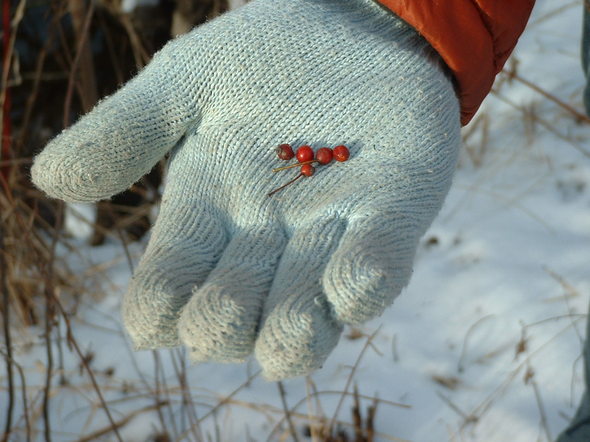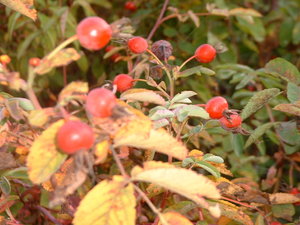Wildcrafting: Rosehips are a simple treat of color and taste in the winter

Rosehips are easy to find in the winter, and the frost improves their flavor. Try one for a burst of fresh citrusy taste.
Linda Diane Feldt | Contributor
Along the edges of the forest, in an urban garden, in a frozen field or along the river, rosehips stand out once the greenery has gone. Easy to identify as the remains of the flower, look for the confirming thorns and brambles with the red or orange seedpods remaining after the flowers have died back.
The hips will vary in size from a ¼ inch to an inch or more, depending on the variety. The flavor also ranges from “spit it out” bad (fermented) to bland and boring, to yummy sweet citrusy bursts. So it is certainly worth tasting them as you find them: you never know until you try!
The flavor generally is improved with the first frost, and birds target the hips as a winter staple. The hips are rich in vitamin C and also impart great flavor and taste to many commercial teas. I have a friend who grew up in Great Britain during World War II. She told me it was considered patriotic to collect rose hips from the country side and these were then made into potions for soldiers and children needing a vitamin C rich tonic.
It takes a lot of work to gather, clean and use the rose hips. It’s easiest with the larger hips, grown to attract birds or for easier harvesting. But just nibbling on them as you walk is a pleasure, and the range of tastes you’ll encounter is interesting.
I was made aware recently that not everyone knows how to enjoy this simple treat. Look for whole, full, well colored hips. Avoid those that seem dried, sunken or moldy. You can nibble the outside, consuming the outer fleshy part. You want to avoid the seeds inside, which are barbed and hairy. If you have a knife, you can split the seedpod and scrape out the white barbed seeds. Some people also just use a fingernail to split the rose hip and scrape out the seeds.

A rose bush full of fruit, along honey creek during warmer weather.
Linda Diane Feldt | Contributor
If you find a great patch and want to save them for later use, you can dry them. At home, split them open, remove the seeds and fine hairs, and either place in the sun or in a slow oven (200 degrees or less) for one to two hours. Once they are dry, store in a jar with a tight lid.
If you make an herbal tea with the rose hips, remember that vitamin C is water soluble. It will go up in the steam. To preserve the vitamin C you will want to steep it with a lid.
I have had the experience many times of finding a great tasting patch of rosehips, only to return later to find they are completely gone. I assume some birds are also looking for this tasty food, and they got to it before I could return.

Rosehips come in many sizes and colors, 1/4 inch to 1 inch or more, and mostly orange and red.
Linda Diane Feldt | Contributor
Winter makes foraging a more sparse passion, so the few things that are edible are much more prized. The summery fresh taste of rosehips, made sweeter by the frost, is a delightful find.
Linda Diane Feldt is a local holistic health practitioner, author, and teacher. Her cookbook “Spinach and Beyond: Loving Life and Dark Green Leafy Vegetables” is available locally at Morgan and York, Crazy Wisdom Bookstore and Tearoom, Nicolas, and from Amazon.com. You can follow her on twitter, visit her website, or contact her ldfeldt(at)holisticwisdom.org.


Comments
Linda Diane Feldt
Fri, Dec 17, 2010 : 4:42 a.m.
Rosehips are safe. However, some can be moldy and some can be partly fermented. Those may not be safe to eat. So look and taste. If you weren't paying attention, it might be possible to mistake them for something like barberry, hard to do but possible, but again taste would make that error obvious. The rosehip will taste good, and have a citrusy note in the flavor.
Kim Kachadoorian
Wed, Dec 15, 2010 : 7:33 a.m.
Are all rosehips safe or are them some to avoid?
Linda Diane Feldt
Tue, Dec 14, 2010 : 10:54 p.m.
My understanding is that any vitamin C rich beverage would benefit from a lid if it is still steaming. Although heat also destroys it. Lower heat and longer steeping with a lid all help.
Laura
Tue, Dec 14, 2010 : 2:25 p.m.
Speaking of water soluble vitamin C...is the C in hibiscus flowers also water soluble? I love hibiscus tea with rosehips!
Linda Diane Feldt
Mon, Dec 13, 2010 : 9:23 p.m.
I haven't made jam from rosehips, but they should be even better now than in the fall, if you can find enough. Just taste them first, find a patch you like.
Tammy Mayrend
Mon, Dec 13, 2010 : 7:57 p.m.
A former neighbor made a wonderful rose hip jam late in the fall each year. Can you still do that with ones you find now?